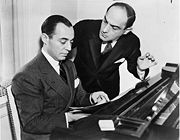Piano Sheets > Rodgers And Hart Sheet Music > Blue Room (ver. 1) Piano Sheet
Blue Room (ver. 1) by Rodgers And Hart - Piano Sheets and Free Sheet Music

About the Song
"Blue Room" is a show tune from the 1926 Rodgers and Hart musical The Girl Friend, where it was introduced by Eva Puck and Sammy White.
It was featured in the 1948 film Words and Music, where it was sung by Perry Como, who played Eddie Lorrison Anders.
It was recorded by Como, on May 29, 1948, and on released as a single on December 17. Rodgers and Hart were an American songwriting partnership consisting of the composer Richard Rodgers (1902 1979) and the lyricist Lorenz Hart (1895 1943).
They worked together on about thirty musicals from 1919 until Hart's death in 1943. Their breakthrough came in 1925 with The Garrick Gaieties, which featured the hit song "Manhattan."
Their many other hits include "Here In My Arms," "Mountain Greenery," "The Blue Room," "My Heart Stood Still," "You Took Advantage of Me," "Ten Cents a Dance," "Dancing on the Ceiling," "Spring is Here," "Lover," "Mimi,".
Download this sheet!
About the Artist

Random article
Piano notes and music reading No language is easy to learn except for our mother tongue. Mother tongue is a language which we start learning as soon as we are conceived. But learning some other language can be difficult if you are really not into it. Piano Notes are written in a completely different language. Agreed that the characters in the piano notes are very artistic and beautiful but they are equally strange to beginners and newcomers. But here is one interesting fact. Learning music reading from a piano notes music sheet is not a very difficult task. Actually it is much easier than learning a foreign Asian language like Chinese. Memorization and repetition are the two main ingredients for success in mastering the language of piano notes. So realistically speaking, once you are done reading the basics, all you have to do is practice the language as much as you can. To say in a very classical tone, practice till each and every note starts running through your veins. (More...)
